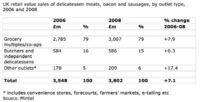 The relegation of bacon and sausages to a weekend treat has opened up new usage occasions, and increased their popularity as a main meal accompaniment. This has helped to stem a significant drop in value sales as consumers look for more premium offerings.
The relegation of bacon and sausages to a weekend treat has opened up new usage occasions, and increased their popularity as a main meal accompaniment. This has helped to stem a significant drop in value sales as consumers look for more premium offerings.
There has been renewed interest in traditional British meals and the rediscovery of good value-for-money food has particularly helped sales of sausages, especially at the premium end of the market.
Within the sector, bacon has suffered from price deflation as grocery multiples run money-off promotions. The decline in consumption of bacon for breakfast has led to volume sales stalling, further impacting on overall market value.
Consumers are price-sensitive in this market. Despite the fact that there is a range of varieties available, from rindless to steaky bacon, two fifths of consumers tend to default to buying the same type of bacon they previously bought, or buying whatever is on special offer.
The government waste management agency WRAP is looking for ways to help households minimise the amount of food that they throw away – which it estimates at 6.7 million tonnes. Special offers such as buy-one-get-one-free often mean that consumers buy more than they can consume, leading to products being thrown away once they reach their use-by date.
Sausages have moved away from being just a breakfast favourite. Higher production costs have had an inflationary effect on this market, yet this has not held the grocery multiples back from offering a wider variety of premium sausages, with better-quality ingredients and a wider choice of flavours. Today, just one in eight of those who eat bacon or sausages say that they are cutting back on buying premium products as they try to save money, while sales of standard-plus and premium sausages are growing faster than the market as a whole. Volume sales are faltering as sausages are not eaten as often for breakfast, restricting volume sales growth.
Meanwhile, deli meats tend to be a low-interest purchase and often consumers stick to the same type of product. They will continue to be the fastest-growing segment, increasing by 20% at current prices from 2009-14.
Concerns over fat and salt levels have prompted producers to reformulate their ranges to meet FSA guidelines set to reduce salt and fat levels in foods. Food producers have to ensure that taste is not compromised when products are reformulated.
In terms of distribution, As consumers look to do all their weekly shopping under the same roof, butchers and other specialist retail outlets have seen their share of sales decline.
Farmers’ markets have increased in popularity as younger, more affluent consumers look for fresh, local produce.
As the bulk of sales go through grocery multiples (79%), consumers have a preference for pre-packed cooked meats and sausages compared to the loose or sliced-to-order option. Whilst there is an acknowledgement that products from delicatessen counters may taste better (and over half of people who eat cooked meats agree that they do), time pressures or lack of product information often means that consumers opt for something from the pre-packed aisles.
Cooked meats are most likely eaten as part of lunch, while bacon and sausages prove quite popular when eaten as part of a traditional ‘English’ meal.




Comments are closed.